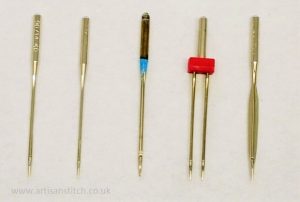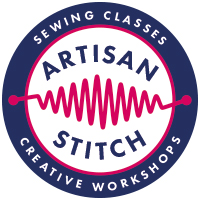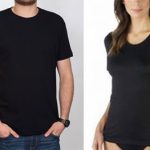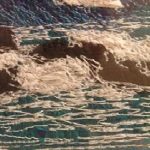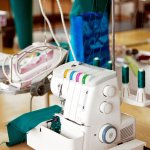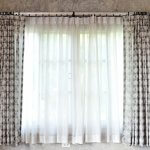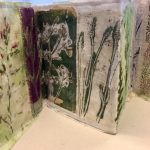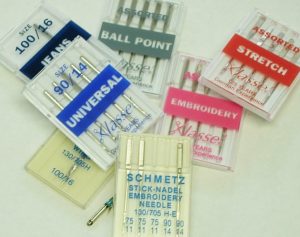
How to choose the best sewing machine needles.
Sewing machine needles come in an assortment of types and sizes. Using the correct needle is important to achieve a successful outcome to your sewing project. The wrong size or type of needle can cause breakages of either needles or thread. Uneven or skipped stitches, and snags or holes in the fabric are also symptoms of the wrong needle. You should choose your needle firstly according to the purpose/project, the fibre-type and fabric construction, then the fabric weight.
Sewing machine needle ‘system’
Modern domestic sewing machines all take one system of needle and that’s 130/705. This is standard across all manufacturers, whether your machine is Brother, Pfaff, Janome, Husqvarna, Bernina, Elna, Singer or any of the other makes.
Which brand is best?
Schmetz are a good quality and very popular brand and produce a large range of needles for various tasks. ‘Klasse’ are readily available in most hobby stores and fabric shops. Organ are also a good quality brand. Expect to pay around £2.20-£2.50 for a packet of 5 universal needles but speciality needles will be more. You don’t have to buy needles that are branded with your specific make of machine. If you look at the packaging of Janome-branded needles closely, you’ll see that they are actually made by Organ but cost about twice as much as Organ needles. See my note about Singer* lower down.
Don’t buy really cheap needles from the supermarket i.e. £1 per packet. It’s a false economy and will only lead to a frustrating sewing session.
The Anatomy of sewing machine needles
The wider part of the needle at the top is the shank. The main ‘stem’ of the needle is the shaft or blade. Look closely and you’ll see a groove running down the front towards the eye. The thread sits in this groove and is protected from wear when passing through the fabric. The ‘scooped-out’ bit at the back is the ‘scarf’ and is to allow the bobbin hook to pass close enough to pick up the thread loop. Make sure the needle is correctly inserted, with the flat side of the shank to the back, and is as high as it will go. Screw it in tightly. Vibration can loosen the needle and cause it to break or drop out. The thread should pass through the eye from front to back. If you do break a needle, check that you have all the bits and that no pieces are lodged anywhere around the feed dogs or in the bobbin cavity. This can cause serious damage to the machine.
Needle Sizes
You also need to use the correct size of needle for the fabric weight. Needles are available in many sizes from 60/8 to the largest being 130/21.The mid-range is 80/12 or 90/14. The first, larger number is the metric sizing and refers to the diameter of the shaft of the needle. So a size ’80’ is 0.8mm. The second smaller number i.e. 12 is the old imperial measurement. What’s easy to remember is that the bigger the number, the bigger the needle.
Use size 60-75 for fine voiles, organza and cotton lawn. A mid-range 80 or 90 is suitable for medium-weight fabrics such as craft cotton, polycotton and cotton sateen. A 100-130 is for heavy wools, denim, cotton duck and upholstery-weight. Many general haberdashery shops will only stock from around 75 to 100. You may have to try a sewing machine dealer or an online supplier for the needle sizes at the extreme ends of this scale. Use a needle that’s too fine and it’ll bend or break; use too thick a needle and you risk damaging the fabric by making bigger holes than is necessary.
Needle types
This is when you need to consider what sort of sewing you’ll be doing, and what fabric you’re using. Then choose your needle accordingly.
Universal
Needle system: 130/705 H or sometimes HAx1
These have a slightly rounded tip and are the go-to choice for many sewing projects using woven fabric (e.g. dressmaking, soft furnishing and crafts).They come in a wide range of sizes from NM 60/8 to NM 130/21. This needle is also the standard fit in modern overlockers.
Ballpoint/jersey
Needle system: 130/705 H-SUK
As you’d expect from the name, these needles have a rounded, blunt tip. They should be used when sewing jersey knit fabrics (e.g.T-shirts). They gently push aside the fibres instead of punching their way through, which prevents holes forming in the fabric, and skipped stitches. These needles can be labelled as either ‘jersey’ or ‘ballpoint’ but they are the same product. Ballpoint or jersey needles can be used on woven fabrics too so it could be argued that they are more versatile than universal.
Stretch
Needle system: 130/705 H-S
Stretch needles are often confused with ballpoint, but they are a different needle and perform a distinct function. Use these for sewing elastic or fabrics containing a high degree of elastic e.g. swimwear. They have a medium ballpoint tip, a shorter eye, and a flatter shank. This allows the needle to be closer to the bobbin hook, preventing skipped stitches.
Super Stretch
Needle system: HAx1 SP
These needles have been developed for easy sewing of highly-elastic fabrics. The flat shank allows the needle to be closer to the bobbin hook. There’s also a special scarf design allowing a larger thread loop, which is more likely to be picked up by the hook. A reinforced shaft reduces likelihood of breakage and allows a straight stitch whilst the chrome coating, instead of nickel is more resistant to abrasion. A wider and shorter eye enable use of thicker threads. The super stretch needle can be used in all sewing machines. Janome recommend HAx1 SP needles for their overlockers. So if you’re experiencing skipped stitches when using universal tip needles in your overlocker then try switching to SUK, stretch or super stretch.
Super Universal
Needle system: 130/705 H-SU
These are a recent development in response to a modern problem. When sewing adhesive hoop and loop tape or fabric treated with spray adhesives, it’s normal to experience a gummed up needle. This causes skipped stitches and thread breakage. Super-universal needles have a particularly smooth, non-stick coating that significantly reduces adhesive build-up. It also has an enlarged eye which is the equivalent to that of a needle two sizes larger. This reduces thread abrasion so this is a good embroidery needle too. The slightly rounded point shape is suitable for most fabric types whilst the reinforced blade penetrates thick fabrics like denim easily.
Microtex (sharps)
Needle system: 130/705 H-M
A very slim, sharp point gives good results when sewing fine or densely-woven fabrics such as microfibre, silk, polyester and taffetta lining. Perfect straight stitches are achieved during topstitching.
Quilting
Needle system: 130/705 H-Q
These have a special taper to their slight-rounded point for easier penetration of fabric layers and eliminate skipped stitches.
Jeans
Needle system: 130/705 H-J
A medium ballpoint tip displaces the fabric for less stress during fabric penetration whilst a reinforced blades copes with heavy fabrics such as canvas, denim and twill. Available in NM 70-110 sizes.
Topstitch
Needle system: 130 N
A long eye of 2mm allows thicker thread to pass unhindered reducing skipped stitched and thread abrasion. A slightly rounded point is suitable for most woven fabrics. Topstitch needles are available in NM70-110 sizes and are a good alternative to embroidery and metallic needles.
Leather
Needle system: 130/705 H-LL
For sewing leather, and hard faux leather/vinyl. This needle has a flat ‘chisel’-shaped tip which cuts a tiny slit instead of making a hole. This prevents the fabric tearing. These needles must not be used on woven or knit fabrics.
Twin/Triple
Needle system: 130/705 H ZWI and others
A twin needle has two separate needles attached to a single shank, and is fitted to the machine like a single needle. You will need two separate thread reels. Thread the machine as normal, running both threads together through the tension discs and the other thread guides until you come to the needles. Then thread each needle separately. The bobbin thread will ‘zig-zag’ between each needle thread, giving a slightly elastic stitch. This is why a twin needle should be used for hems in knitted fabrics, rather than two separate rows of stitching. You may need to loosen the bobbin tension to prevent ‘tunnelling’. Twin needles come in a range of variations for different tasks. i.e. jersey, denim, embroidery and metallic variables. The ballpoint option enables T-shirt hems to be sewn with a degree of stretch. Otherwise, create parallel rows of topstitching or pintucks quickly and easily. There’s even a hemstitch option with a wing for decorative effects in Heirloom sewing. Available in different widths with common options being 1.6mm to 4mm. Any swing-needle sewing machine can be fitted with a twin needle.
Overlocker/Serger needles
Needle system: ELx705 CF or ELx705 SUK CF
Yes I’ve said above that overlockers do well with either universal, ballpoint (130/705 H or 130/705 H-SUK) or superstretch needles (HAx1 SP). But they’ll do even better with the ELx705 and variants. There’s a belief going around that the ‘EL’ stands for extra long and will result in damage to the machine. It doesn’t, and it won’t. These needles are the same dimensions as 130/705 etc and were developed by Schmetz especially for the Elna Lock overlocker. They have a groove front and back which aids the formation of the chain stitches and a reinforced blade for extra strength. The ‘CF’ part of the name means ‘Chrome finish’. And not only can these needles improve stitch quality in overlockers and coverstitch machines, but they can be used in regular sewing machines too.
Singer brand needles
*There is a myth going around that Singer sewing machines and overlockers must have Singer-branded needles as they are 1mm longer. This is not true as the length of all sewing machine needles has been standardized. But on close examination, the packaging for Singer universal and ballpoint needles, (coded 2020 and 2045 respectively) also shows the system 130/705H. Similarly, Singer overlocker needles (coded 2022) have ELx705 on the packet. Excuse me for being cynical, but I suspect it’s a ploy to sell you the same product at three times the price. And if you don’t believe me, then measure the needles between two rulers.
How often should I change my needles?
Finally, the crucial question. The answer? After every sewing project (or about 6-8 hours of sewing). No matter the effort you’ve put in to choose the best needle for your project, you won’t get good results if it’s blunt. Also, if you hit a pin, then check your needle for a bent tip. If you feel any rough edges or burrs then change it to avoid fabric damage and/or stitching problems.
Useful links:
